Why can not we judge health by BMI?

ByPaola Kizette Cimenti
Many people are concerned about whether their bodies are healthy. There are a number of measures to measure health, weight and body fat percentage, etc. There are, among others, the body mass index showing obesity degree "BMI"Is widely used. BMI is a numerical value that can be calculated if you know your height and weight, and it is widely used for the convenience that you do not need to look up other information such as average weight and average body fat, but "BMI There is a limit to judging health by health. " A movie that explains its contentsWhat BMI does not tell you about your health"Official YouTube channel of Vox.com to explain the current news is released.
What BMI does not tell you about your health - YouTube
"Body Mass Index" used in the term "BMI" is an index used to measure the degree of health such as obesity, which was born more than 200 years.
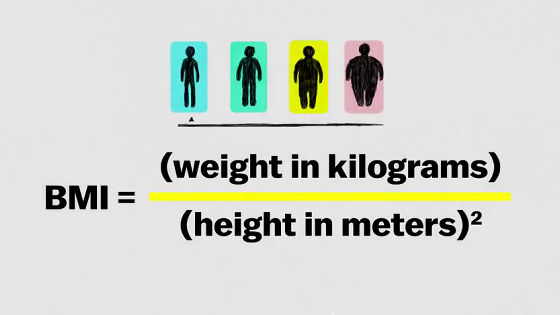
For calculating BMI, use height and weight. I will calculate the BMI of two men in the image below, Coleman (left) and Phil (right). The two men are about the same in weight and height. In other words, the two person BMI is calculated almost the same. Coleman's "24.6" for BMI and Phil's "24.7" for BMI, respectively.

However, although the BMI of two men is almost the same, the body fat percentage of two people, which is a major index related to health, is not almost the same as BMI.

Phil's body fat rate is 7.9 points higher, Coleman's body fat percentage is "20.5 percent", Phil's "28.4 percent", Phil's body fat percentage is greatly different. The result that the degree of obesity is different though it is two men with the same BMI.
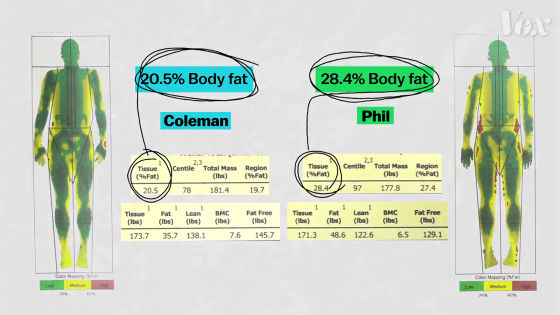
Based on the above results, the difference between the two bodies is that Mr. Coleman is more muscular than Phil and Phil is more body fat than Coleman.
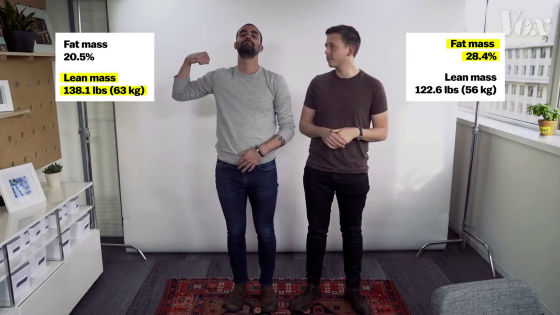
BMI is a popular way to evaluate whether people are healthy or healthy. However, as is clear from the difference between these two men, using BMI's numerical values to judge diseases caused by obesity is prone to mistakes, so it is said that BMI is less frequently used.

This point "The fact that it is inaccurate to measure obesity with BMI" has also been raised from many media such as U.S.NEWS, TEENVOGUE, New York Time and Refinery 29. The information that BMI brings appears as a result of different nuances that we want to know.

The place has changed, this is the "Weight Management and Human Performance Institute" by George Washington University.

About BMI Director of Research Institute Todd Miller says: "The method of calculating the BMI index is done by dividing the weight of the subject by the height"

"Therefore, we mainly use weight as the calculation method"

The exact calculation method divides the subject's weight by the square of the height. In addition, weight is used in kilogram units, height is in meters.

Classification of the degree of obesity according to the calculated BMI value classifies the degree of obesity of the body type to "Body weight shortage of 18.5 or less", "Healthy range of 18.5 to 24.9", "Overweight of 25 to 29.9" and " Over 30 are obese ". Incidentally,For Japanese people, BMI is over 25 and obeseThere is also a way of thinking to classify it.

"The foundation of BMI 's way of thinking is that weight gets heavier as height is higher."

"It is strange that it is a matter of being divided into overweight to overweight simply by increasing BMI from 29.9 to 0.01 to 30.0, which is a split."

Miller's director claims that there is a big problem in using BMI as an indicator of health. For example, the BMI index is calculated poorly the more muscle is healthy.

As an example, I will calculate BMI with American football player Marshawn Lynch. Then, Lynch is 180 cm tall and weighs 98 kg, so BMI is 30.0.

In other words, Lynch is classified as "Obesity" because BMI is 30.0, despite the fact that fat is low and the muscle is rich. The cause of being classified as obese is that BMI does not distinguish between muscle and fat.

"Our researchers are investigating the extent to which the muscles will affect the body, focusing on heartbeat, muscles are the driving force of metabolism, and the body creates heat."

"With a healthier body fat percentage, more muscles, and lower stature will not match BMI."

Reliability as a sign of BMI 's health declines when measured by athletes. The reason is that when you measure the BMI of an athlete, it indicates that the athlete is obese, such as "36.9", "30.9", "25.7", "34.8".

Furthermore, there are difficult factors to make BMI an indicator of health. It is to change with age, gender and ethnic differences. This means "Centers for Disease Control and Prevention"(American Centers for Disease Control and Prevention: CDC) announced.
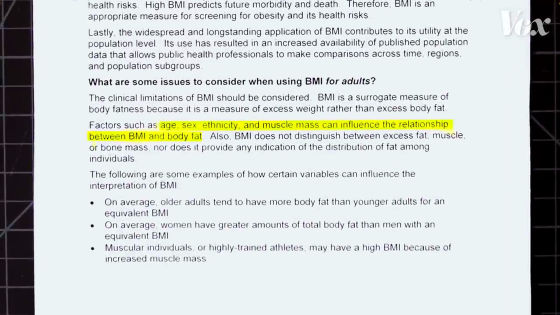
I have pointed out the shortcomings of BMI so far. On the other hand, BMI seems to have a useful usage. BMI is effective when preparing health measures for large population. For example, it can be used to compare relative obesity rates by state.

By using this method, it is possible to relieve individual health problems relatively.

From here we will review the history of BMI. Body "Body Mass Index" was born in the first half of the 19th century.

It was Belgian mathematician Lambert Adolphe Jacques Quetele who produced the formula for calculating BMI. BMI is often used in connection with health, but Mr. Quetele is not a doctor. The reason why Mr. Quetele created the official was to calculate "regular male" as a research, not an official formulation for obesity research purposes.

The reason why the use purpose of BMI came to be used for judgment of health was Mr. Ancel Keys in 1972.

Mr. Keys from the University of California used the BMI calculation formula in the Obesity research paper "Indices of Relative Weight and Obesity (index of relative load and obesity)" in 1972.

In this study of obesity, Keys named the formula that Quetele created in the first half of the 19th century as "body mass index" and used it in the research paper. By having a new name, BMI was received as a "new instrument" among researchers, and it took a lot of attention.

Since that year, the use frequency of BMI in health specialty field has increased.

Using BMI as an indicator of health has had merit. It's easy to use, inexpensive, understands the result faster, and in many cases is fair. Thus BMI was used for more than 200 years. However, BMI is not the ultimate health indicator after all.
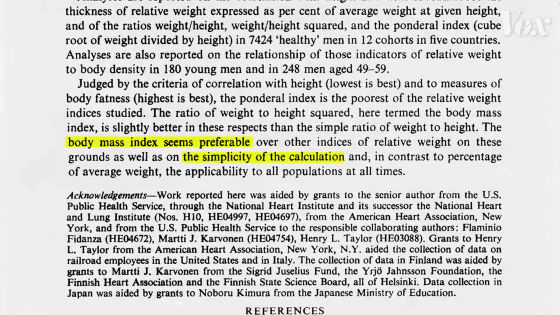
In retrospect, in modern times, there are many other things that are indicative of body composition and general health concerning health.

For example, health indicators include the underwater weight method, MRI scan results, three sizes from waist to hip, and blood pressure and blood glucose levels measured by medical examination.

George Washington University's "Weight Management and Human Performance Laboratory" as one of the ways to infer healthDual-Energy X-ray ABSORPTIOMETRY"(DEXA Act) has been introduced.

The DEXA method can measure overall body composition, body fat, bone density, etc.

On the screen, the body composition of the subject measured by the DEXA method is displayed as color. The green part of the body shown on the screen is the muscle area. Yellow is a moderate fat area, and the red part is an area where the amount of fat is excessive.

The state of the subject's body that was previously displayed on the screen by the DEXA law is shown in the following chart. Here we summarize the changes in fat and muscle changes from July 3 to December 27 of a year.
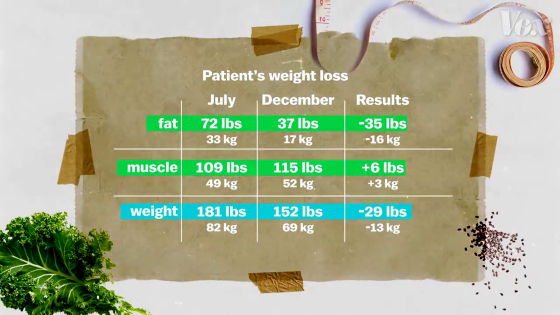
In this chart, the weight is reduced by 13 kg in about six months from July 3 to December 27 ... ...
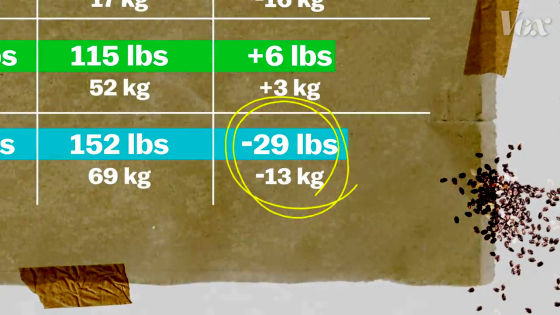
Muscle has increased 3 kg in about six months. As this result of muscle increase etc does not appear in weight, it can not be measured accurately if it is BMI.
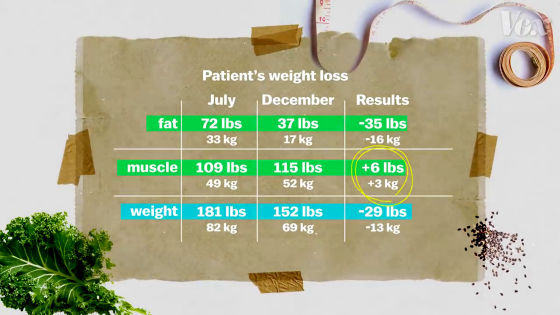
This result shows that BMI alone can not measure health accurately so that the BMI of the two men at the beginning of the movie are almost the same.

BMI is an indirect measurement method of measuring aspects of individual health. BMI is a reference for health, but it should not be the only way to understand the human body.

Related Posts:







